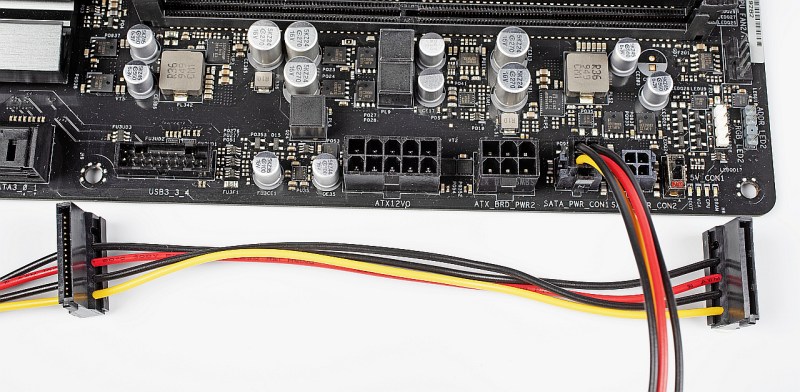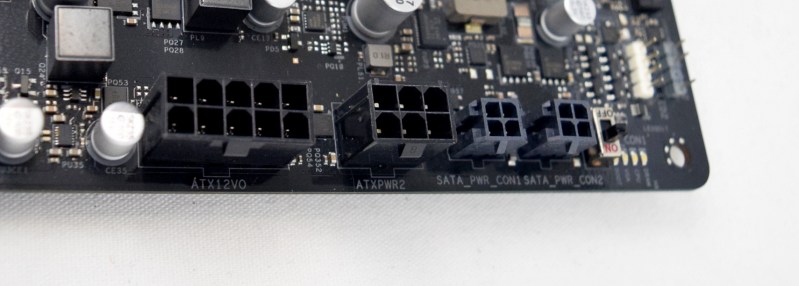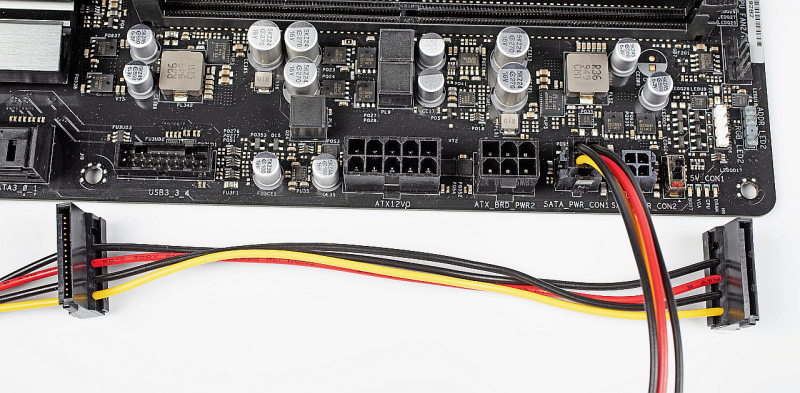
The venerable ATX standard was developed in 1995 by Intel, as an attempt to standardize what had until then been a PC ecosystem formed around the IBM AT PC’s legacy. The preceding AT form factor was not so much a standard as it was the copying of the IBM AT’s approximate mainboard and with it all of its flaws.
With the ATX standard also came the ATX power supply (PSU), the standard for which defines the standard voltage rails and the function of each additional feature, such as soft power on (PS_ON). As with all electrical appliances and gadgets during the 1990s and beyond, the ATX PSUs became the subject of power efficiency regulations, which would also lead to the 80+ certification program in 2004.
Starting in 2019, Intel has been promoting the ATX12VO (12 V only) standard for new systems, but what is this new standard about, and will switching everything to 12 V really be worth any power savings?
What ATX12VO Is
As the name implies, the ATX12VO standard is essentially about removing the other voltage rails that currently exist in the ATX PSU standard. The idea is that by providing one single base voltage, any other voltages can be generated as needed using step-down (buck) converters. Since the Pentium 4 era this has already become standard practice for the processor and much of the circuitry on the mainboard anyway.
As the ATX PSU standard moved from the old 1.x revisions into the current 2.x revision range, the -5V rail was removed, and the -12V rail made optional. The ATX power connector with the mainboard was increased from 20 to 24 pins to allow for more 12 V capacity to be added. Along with the Pentium 4’s appetite for power came the new 4-pin mainboard connector, which is commonly called the “P4 connector”, but officially the “+12 V Power 4 Pin Connector” in the v2.53 standard. This adds another two 12 V lines.

In the ATX12VO standard, the -12 V, 5 V, 5 VSB (standby) and 3.3 V rails are deleted. The 24-pin connector is replaced with a 10-pin one that carries three 12 V lines (one more than ATX v2.x) in addition to the new 12 VSB standby voltage rail. The 4-pin 12 V connectors would still remain, and still require one to squeeze one or two of those through impossibly small gaps in the system’s case to get them to the top of the mainboard, near the CPU’s voltage regulator modules (VRMs).
While the PSU itself would be somewhat streamlined, the mainboard would gain these VRM sections for the 5 V and 3.3 V rails, as well as power outputs for SATA, Molex and similar. Essentially the mainboard would take over some of the PSU’s functions.
Why ATX12VO exists

The folk over at GamersNexus have covered their research and the industry’s thoughts on the topic of ATX12VO in an article and video that were published last year. To make a long story short, OEM system builders and systems integrators are subject to pretty strong power efficiency regulations, especially in California. Starting in July of 2021, new Tier 2 regulations will come into force that add more strict requirements for OEM and SI computer equipment: see 1605.3(v)(5) (specifically table V-7) for details.
In order to meet these ever more stringent efficiency requirements, OEMs have been creating their own proprietary 12 V-only solutions, as detailed in GamersNexus’ recent video review on the Dell G5 5000 pre-built desktop system. Intel’s ATX12VO standard therefore would seem to be more targeted at unifying these proprietary standards rather than replacing ATX v2.x PSUs in DIY systems. For the latter group, who build their own systems out of standard ATX, mini-ITX and similar components, these stringent efficiency regulations do not apply.
The primary question thus becomes whether ATX12VO makes sense for DIY system builders. While the ability to (theoretically) increase power efficiency especially at low loads seems beneficial, it’s not impossible to accomplish the same with ATX v2.x PSUs. As stated by an anonymous PSU manufacturer in the GamersNexus article, SIs are likely to end up simply using high-efficiency ATX v2.x PSUs to meet California’s Tier 2 regulations.
Evolution vs Revolution

Ever since the original ATX PSU standard, the improvements have been gradual and never disruptive. Although some got caught out by the negative voltage rails being left out when trying to power old mainboards that relied on -5 V and -12 V rails being present, in general these changes were minor enough to incorporate these into the natural upgrade cycle of computer systems. Not so with ATX12VO, as it absolutely requires an ATX12VO PSU and mainboard to accomplish the increased efficiency goals.
While the possibility of using an ATX v2.x to ATX12VO adapter exists that passively adapts the 12 V rails to the new 10-pin connector and boosts the 5 VSB line to 12 VSB levels, this actually lowers efficiency instead of increasing it. Essentially, the only way for ATX12VO to make a lot of sense is for the industry to switch over immediately and everyone to upgrade to it as well without reusing non-ATX12VO compatible mainboards and PSUs.
Another crucial point here is that OEMs and SIs are not required to adopt ATX12VO. Much like Intel’s ill-fated BTX alternative to the ATX standard, ATX12VO is a suggested standard that manufacturers and OEMs are free to adopt or ignore at their leisure.
Important here are probably the obvious negatives that ATX12VO introduces:
- Adding another hot spot to the mainboard and taking up precious board space.
- Turning mainboard manufacturers into PSU manufacturers.
- Increasing the cost and complexity of mainboards.
- Routing peripheral power (including case fans) from the mainboard.
- Complicating troubleshooting of power issues.

Add to this potential alternatives like Seasonic’s CONNECT module. This does effectively the same as the ATX12VO standard, removing the 5 V and 3.3 V rails from the PSU and moving them to an external module, off of the mainboard. It can be fitted into the area behind the mainboard in many computer cases, making for very clean cable management. It also allows for increased efficiency.
As PSUs tend to survive at least a few system upgrades, it could be argued that from an environmental perspective, having the minor rails generated on the mainboard is undesirable. Perhaps the least desirable aspect of ATX12VO is that it reduces the modular nature of ATX-style computers, making them more like notebook-style systems. Instead, a more reasonable solution here might be that of a CONNECT-like solution which offers both an ATX 24-pin and ATX12VO-style 10-pin connectivity option.
Thinking larger
In the larger scheme of power efficiency it can be beneficial to take a few steps back from details like the innards of a computer system and look at e.g. the mains alternating current (AC) that powers these systems. A well-known property of switching mode power supplies (SMPS) like those used in any modern computer is that they’re more efficient at higher AC input voltages.

This can be seen clearly when looking for example at the rating levels for 80 Plus certification. Between 120 VAC and 230 VAC line voltage, the latter is significantly more efficient. To this one can also add the resistive losses from carrying double the amps over the house wiring for the same power draw at 120 V compared to 230 VAC. This is the reason why data centers in North America generally run on 208 VAC according to this APC white paper.
For crypto miners and similar, wiring up their computer room for 240 VAC (North American hot-neutral-hot) is also a popular topic, as it directly boosts their profits.
Future Outlook
Whether ATX12VO will become the next big thing or fizzle out like BTX and so many other proposed standards is hard to tell. One thing which the ATX12VO standard has against it is definitely that it requires a lot of big changes to happen in parallel, and the creation of a lot of electronic waste through forced upgrades within a short timespan. If we consider that many ATX and SFX-style PSUs are offered with 7-10 year warranties compared to the much shorter lifespan of mainboards, this poses a significant obstacle.
Based on the sounds from the industry, it seems highly likely that much will remain ‘business as usual’. There are many efficient ATX v2.x PSUs out there, including 80 Plus Platinum and Titanium rated ones, and Seasonic’s CONNECT and similar solutions would appeal heavily to those who are into neat cable management. For those who buy pre-built systems, the use of ATX12VO is also not relevant, so long as the hardware is compliant to all (efficiency) regulations. The ATX v2.x standard and 80 Plus certification are also changing to set strict 2-10% load efficiency targets, which is the main target with ATX12VO.
What would be the point for you to switch to ATX12VO, and would you pick it over a solution like Seasonic CONNECT if both offered the same efficiency levels?
(Heading image: Asrock Z490 Phantom Gaming 4SR with SATA power connected, credit: c’t)


Recent Comments